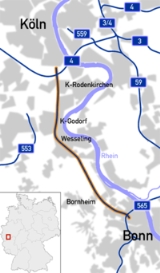
Bundesautobahn 555
Encyclopedia
Bundesautobahn 555 connecting the cities of Cologne
and Bonn
, was constructed between 1929 and 1932, and opened to traffic on August 6, 1932.
Because it was the first public road that was limited to motorized vehicles and had no level crossings, it is commonly regarded as the oldest German Autobahn, even though it was only a country road at first and wasn't officially awarded Autobahn status until 1958. Until it was extended to six lanes between 1964 and 1966, there was no central barrier.
Except for deceleration at each end, the A 555 did not have a speed limit, resulting in about 15 km of mostly straight three-lane-road on flat terrain, enabling motorists to drive their vehicles at top speed. Especially at night, speeds in excess of 200 km/h were not unusual. In 2004, however, a speed limit was introduced around Wesseling for reasons of noise reduction, effectively cutting the area for legal speeding in half.
In Cologne
, the A 555 spur has the by-name "Diplomatenrennbahn" (Diplomat race track), seemingly because foreign diplomats and state visitors liked to take a spin from Bonn to Cologne and back when Bonn still was the capital of the Federal Republic of Germany
. Bonn locals, however, use that term for the B 9 where diplomats regularly sped under protection of diplomatic immunity
.
(Kölner Ring)
Cologne
Cologne is Germany's fourth-largest city , and is the largest city both in the Germany Federal State of North Rhine-Westphalia and within the Rhine-Ruhr Metropolitan Area, one of the major European metropolitan areas with more than ten million inhabitants.Cologne is located on both sides of the...
and Bonn
Bonn
Bonn is the 19th largest city in Germany. Located in the Cologne/Bonn Region, about 25 kilometres south of Cologne on the river Rhine in the State of North Rhine-Westphalia, it was the capital of West Germany from 1949 to 1990 and the official seat of government of united Germany from 1990 to 1999....
, was constructed between 1929 and 1932, and opened to traffic on August 6, 1932.
Because it was the first public road that was limited to motorized vehicles and had no level crossings, it is commonly regarded as the oldest German Autobahn, even though it was only a country road at first and wasn't officially awarded Autobahn status until 1958. Until it was extended to six lanes between 1964 and 1966, there was no central barrier.
Except for deceleration at each end, the A 555 did not have a speed limit, resulting in about 15 km of mostly straight three-lane-road on flat terrain, enabling motorists to drive their vehicles at top speed. Especially at night, speeds in excess of 200 km/h were not unusual. In 2004, however, a speed limit was introduced around Wesseling for reasons of noise reduction, effectively cutting the area for legal speeding in half.
In Cologne
KOLN
KOLN, digital channel 10, is the CBS affiliate in Lincoln, Nebraska. It operates a satellite station, KGIN, on digital channel 11 in Grand Island. KGIN repeats all KOLN programming, but airs separate commercials...
, the A 555 spur has the by-name "Diplomatenrennbahn" (Diplomat race track), seemingly because foreign diplomats and state visitors liked to take a spin from Bonn to Cologne and back when Bonn still was the capital of the Federal Republic of Germany
Germany
Germany , officially the Federal Republic of Germany , is a federal parliamentary republic in Europe. The country consists of 16 states while the capital and largest city is Berlin. Germany covers an area of 357,021 km2 and has a largely temperate seasonal climate...
. Bonn locals, however, use that term for the B 9 where diplomats regularly sped under protection of diplomatic immunity
Diplomatic immunity
Diplomatic immunity is a form of legal immunity and a policy held between governments that ensures that diplomats are given safe passage and are considered not susceptible to lawsuit or prosecution under the host country's laws...
.
Exit list
(Kölner Ring)

